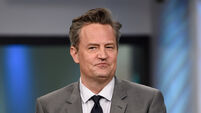It’s the end of the Road as Bob Hope bows out
Mr Hope, whose death at age 100 was announced yesterday, perfected an exquisite comic timing and winning screen persona - the faint-hearted but lovable smart-aleck - that made him one of the biggest box office stars of his generation and sustained a film career spanning six decades.
He also introduced one of Hollywood’s great theme songs, “Thanks for the Memory,” the wistful tune he first performed with Shirley Ross in his 1938 feature debut, “The Big Broadcast,” and ultimately adopted as his signature song.
Never regarded as more than a mediocre actor, Hope became an institution by essentially playing himself. His ski-slope nose and rapid-fire quips were all part of the character he assumed on film, on radio and later on television.
“His appeal with his movie persona was that it was so self-deprecating,” said Leonard Maltin, film critic for the television show “Entertainment Tonight.” “He was anything but a hero. He was a coward, an unsuccessful lady’s man -- that was the fun of it. And because the movie persona blurred with his radio and TV image, you felt as if you really knew this guy.”
Mr Hope was not an instant film success, however. He failed his first screen test in 1930, joking in retrospect that “my nose came into the frame 10 seconds before I did.” It was nearly a decade before he broke into the big-screen big leagues.
Gradually moving from Broadway revues into radio and film, Hope started out doing a number of comedy shorts for Warner Bros. before Paramount Pictures signed him in 1938. He first appeared in features with loud-mouth comic actress Martha Raye and the soulful Shirley Ross as he struggled to define himself on screen.
Hope finally established his trademark alter ego - and launched himself to stardom - in Paramount’s 1939 comic remake of spooky-house chiller “The Cat and the Canary,” playing the wisecracking, fraidy-cat hero who gets as many laughs for lines delivered to his fellow players as for his “outside-the-plot” asides to the audience.
That film led to more in-jokes and topical references the following year in “The Ghost Breakers,” where Hope was reunited with “Canary” co-star Paulette Goddard.
That same year, Hope embarked on what would become one of the legendary partnerships of the silver screen, teaming up with crooner Bing Crosby in “Road to Singapore,” a screwball comedy about about two playboys who swear off women until they meet sarong-clad siren Dorothy Lamour.
The film became a surprise hit and sparked a succession of “Road” movies, owing much of their popularity to the easy chemistry and often ad-libbed verbal sparring between Hope and Crosby. The two were a study in contrasts.
Hope was the more exaggerated of the pair, forever confident he could outsmart the polished, low-key Crosby only to fall for Crosby’s schemes, and always dumbfounded to lose Lamour to his partner in the end.













